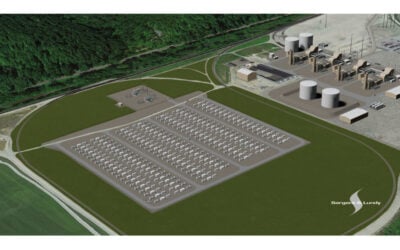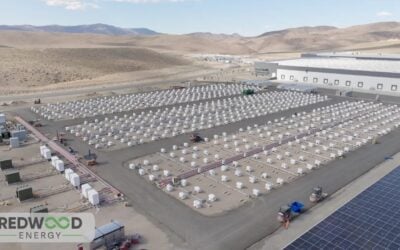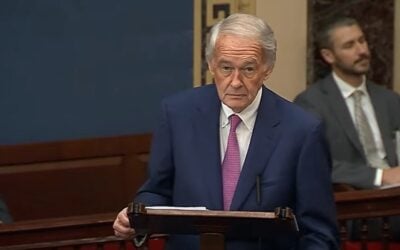Other US states are expected to start joining leaders including California and Hawaii in reconfiguring their landscape to accomodate storage better, Ravi Manghani of GTM said. Image: Southern California Edison.
A small number of regional markets are leading the way for energy storage deployment in the US, but this is likely to change in the near future, an analyst from GTM Research has said.
Currently, California, Hawaii and the large service area of regional transmission organisation, PJM, are dominating headlines, with the latter hosting a frequency regulation market for grid-balancing which has seen numerous large-scale storage projects deployed. Ravi Manghani, energy storage analyst at GTM, told PV Tech Storage that he also sees near-term potential for Texas and New York to join the three leaders.
Enjoy 12 months of exclusive analysis
- Regular insight and analysis of the industry’s biggest developments
- In-depth interviews with the industry’s leading figures
- Annual digital subscription to the PV Tech Power journal
- Discounts on Solar Media’s portfolio of events, in-person and virtual
“For now, as the map shows, most activities are in California, PJM and Hawaii,” Maghani said.
“This is likely to change. For instance the push by Texas utility, Oncor, earlier this year to influence Texas legislation, or New York REV looking at participation of distributed energy resources, including storage for efficient distribution grid operations. It will take a few years of policy and regulatory modifications.”
Manghani and his team published the latest volume of its ‘US Energy Storage Monitor’ last week, looking at deployments and drivers in the first quarter of the year, across residential as well as non-residential segments. In addition to finding that around 5.8MW of storage was installed in Q1 2015, meaning there was a 16% increase in the amount of storage installed over the same quarter in 2014, and that system prices continue to decline as expected, GTM predicts that there will be “significant growth” across all sectors this year in the US.
In total, this year could see 220MW deployed, the report predicts, pointing out that activity in the first quarter of the year is seasonally expected to be somewhat constrained. Each segment will more than double on an annual basis and by 2019 the annual US market will total 848MW, GTM believes.
In addition to continued activity in early adopter or mandate-driven regions such as California, and high-level moves to enable markets for storage in Texas and New York, GTM’s report also highlights policy shifts or trial programmes in other states to accommodate storage.
For example, in front of the meter, the state of Oregon will introduce a mandate for electric utilities to procure storage, 5MW by 2020, which is dwarfed by California’s 1.35GW target, but nonetheless represents a major change in policy. As well as at state level, GTM highlights utility companies and transmission operators that are running pilot programmes and otherwise deploying storage at significant scales. At a national level, the Federal Energy Regulation Commission (FERC) has been looking into changing the rules for grid-balancing frequency response services to allow storage to provide them, the report points out.
Behind the meter, in other words for customer-sited storage, regions where similar shifts are taking place include Illinois, where a US$300 million microgrid programme is expected to be enabled by legislation and New Jersey, where the state Board of Public Utilities (BPU) will support 8.75MW of storage across 13 projects pairing renewables and storage, with an award of US$2.9 million.
GTM also pinpoints possible growth in Arizona, where Arizona Public Service (APS) will deploy up to 2MW of distributed solar-plus-storage, as well as providing US$1 million in rebates for a solar-plus-storage pilot programme. Interestingly, at residential level, Arizona could also be one of the next states to consider “non-volumetric” charging, which could include time of use charges – something that Manghani said is likely to spread across the US. At present, there is a good economic case for storage at commercial scale in many parts of the US which already apply time-of-use and demand charges for peak use.
GTM predicts all sectors to double annually, leading to an annual market of 848MW by 2019. Image: SolarCity.
According to Manghani, “time-of-use tariffs in multiple markets, and solar markets moving away from retail net energy metering policies” will make a big difference in the viability of energy storage, especially paired with solar in the home.
“These rate structure reforms meaningfully change behind-the-meter energy storage economics,” Manghani said.
Manghani also alluded to the fact that the combined energy storage capabilities of residential systems could also be used to help balance the grid, something that has increasingly been looked at by big solar players like SolarCity in the US, and by utilities such as the 100% renewable-powered Lichtblick in Germany. According to Manghani, this is something of a “wildcard” in terms of what the effect could be on the market, if successful.
“Behind-the-meter storage can provide multiple use cases at load centres, which will enable utilities and grid operators to benefit, in addition to end-customer benefits,” Manghani said.
However, as with utility-scale storage policy and regulation, it will take some time for this to take off, he said.
“We are still years away from rules and market conditions for monetisation and distribution of these use cases to all involved stakeholders.”
Finally, in addition to examining battery pricing in detail across the industry, through which GTM found utility-scale systems to be at median price of US$900 per kWh, non-residential (commercial) storage at a median of US$1,100 per kWh and median prices for residential at US$1,500 per kWh, no report on the first quarter of this year would be complete without a look at Tesla. GTM says that “the key bottleneck” in Tesla’s ability to meet orders will be construction of the firm’s Gigafactory in Nevada.
“Tesla expects to meet this demand by the middle of 2016. It is plausible that the US$250 per kWh (for utility-scale storage) is the target price point at full capacity utilisation of production lines in [the] Gigafactory,” the report said, although GTM also highlighted that pressure on the rest of the industry to meet Tesla’s competitive pricing will be felt, but not “right away”.






